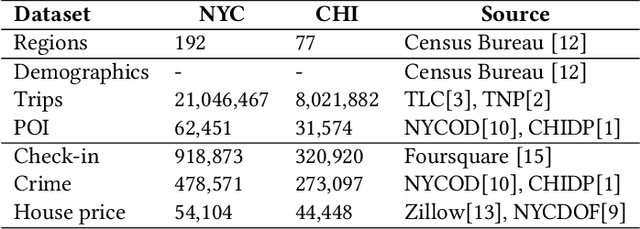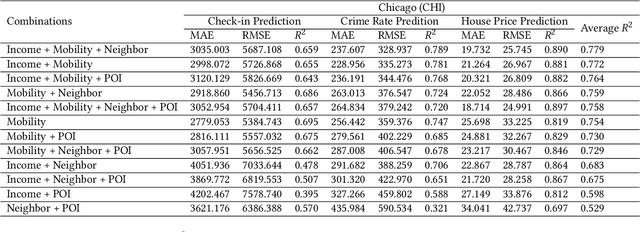Ya Wen
Demo2Vec: Learning Region Embedding with Demographic Information
Sep 25, 2024



Abstract:Demographic data, such as income, education level, and employment rate, contain valuable information of urban regions, yet few studies have integrated demographic information to generate region embedding. In this study, we show how the simple and easy-to-access demographic data can improve the quality of state-of-the-art region embedding and provide better predictive performances in urban areas across three common urban tasks, namely check-in prediction, crime rate prediction, and house price prediction. We find that existing pre-train methods based on KL divergence are potentially biased towards mobility information and propose to use Jenson-Shannon divergence as a more appropriate loss function for multi-view representation learning. Experimental results from both New York and Chicago show that mobility + income is the best pre-train data combination, providing up to 10.22\% better predictive performances than existing models. Considering that mobility big data can be hardly accessible in many developing cities, we suggest geographic proximity + income to be a simple but effective data combination for region embedding pre-training.
Enhancing Campus Mobility: Achievements and Challenges of Autonomous Shuttle "Snow Lion''
Jan 17, 2024Abstract:The rapid evolution of autonomous vehicles (AVs) has significantly influenced global transportation systems. In this context, we present ``Snow Lion'', an autonomous shuttle meticulously designed to revolutionize on-campus transportation, offering a safer and more efficient mobility solution for students, faculty, and visitors. The primary objective of this research is to enhance campus mobility by providing a reliable, efficient, and eco-friendly transportation solution that seamlessly integrates with existing infrastructure and meets the diverse needs of a university setting. To achieve this goal, we delve into the intricacies of the system design, encompassing sensing, perception, localization, planning, and control aspects. We evaluate the autonomous shuttle's performance in real-world scenarios, involving a 1146-kilometer road haul and the transportation of 442 passengers over a two-month period. These experiments demonstrate the effectiveness of our system and offer valuable insights into the intricate process of integrating an autonomous vehicle within campus shuttle operations. Furthermore, a thorough analysis of the lessons derived from this experience furnishes a valuable real-world case study, accompanied by recommendations for future research and development in the field of autonomous driving.
 Add to Chrome
Add to Chrome Add to Firefox
Add to Firefox Add to Edge
Add to Edge